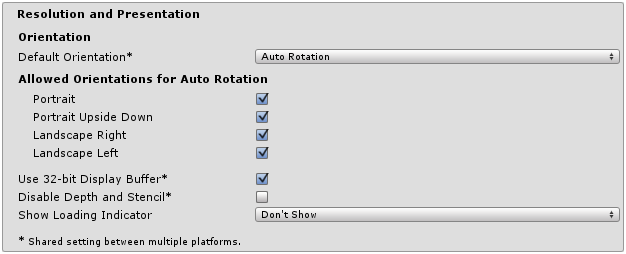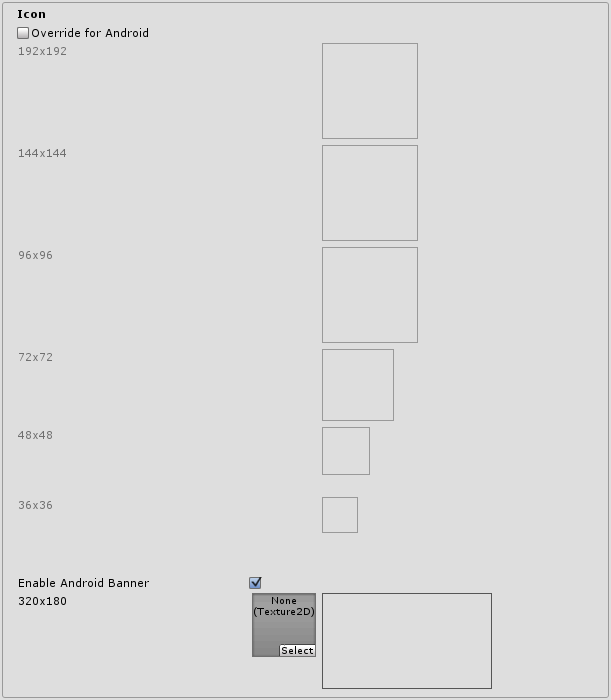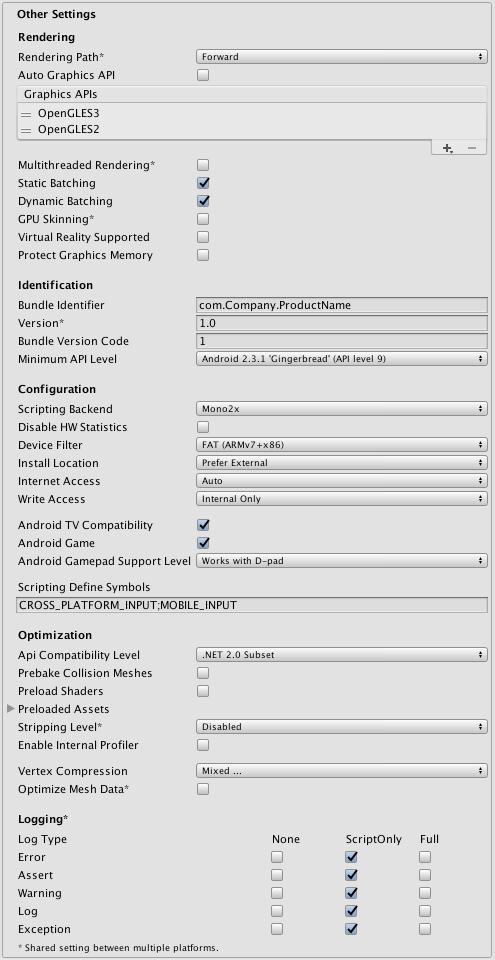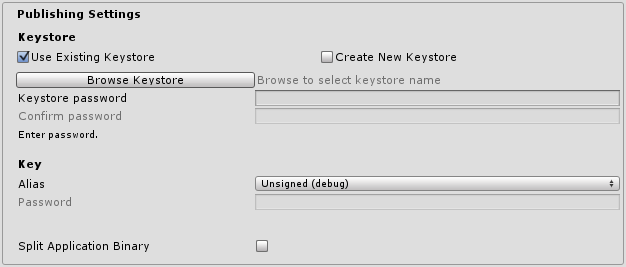- Unity User Manual (5.5)
- Indicaciones Específicas de Plataforma
- Android
- Ajustes del Android Player
Ajustes del Android Player
Esta página detalla los Player Settings específicos a Android. Una descripción general de los Player Settings se puede encontrar aquí.
Resolución y Presentación

| Propiedad: | Función: |
|---|---|
| Orientation | |
| Default Orientation | La orientación de la pantalla del juego. Las opciones son Portrait (botón de inicio abajo), Portrait Upside Down (botón de inicio en la parte de arriba, Android 2.3+), Landscape Left (botón de inicio en el lado derecho) y Landscape Right (botón de inicio en el lado izquierdo, Android 2.3+). |
| Allowed Orientations for Auto Rotation | |
| Allowed Orientations for Auto Rotation | (Solamente visible cuando la Default Orientation esté configurada a Auto Rotation.) |
| Portrait | Permite la orientación portrait |
| Portrait Upside Down | Permite la orientación portrait pero al revés. |
| Landscape Right | Permite la orientación landscape a la derecha (ie, botón de inicio en el lado izquierdo). |
| Landscape Left | Permite la orientación landscape izquierda (botón de inicio está en el lado derecho). |
| Other | |
| Use 32-bit Display Buffer | Specifies if Display Buffer should be created to hold 32-bit color values (16-bit by default). Use it if you see banding, or need alpha in your ImageEffects, as they will create RTs in same format as Display Buffer. Not supported on devices running pre-Gingerbread OS (will be forced to 16-bit). |
| Disable Depth and Stencil | Deberían estar los depth y stencil buffers desactivados? |
| Show Loading Indicator | El indicador del tipo de progreso cargando que debería mostrarse. Las opciones son Don’t Show, Large, Inversed Large, Small e Inversed Small. |
Icono

| Propiedad: | Función: |
|---|---|
| Override for Android | Marque si usted quiere anular el icono predeterminado con uno personalizado para Android. Las imágenes icono de diferentes tamaños se pueden arrastrar a los cuadrados apropiados. |
| Enable Android Banner | Habilita un banner personalizado para construcciones Android T.V |
Splash Image

| Propiedad: | Función: |
|---|---|
| Virtual Reality Splash Screen (Pro-solamente característica) | Específica la textura que debe ser utilizada para el Android splash screen una aplicación de Realidad Virtual. |
| Android Splash Screen (Pro-solamente característica) | Especifica la texturas que debe ser utilizada para el Android splash screen. El tamaño estándar para la splash screen image es 320x480. |
| Splash Scaling | Especifica cómo la imagen splash será escalada para que encaje la pantalla del dispositivo. Las opciones son Center (solamente se escala abajo), Scale to Fit (encaje) y Scale to Fill (cortado). |
Ver también los ajustes de la Unity Splash Screen.
Otros ajustes

| Propiedad: | Función: |
|---|---|
| Rendering | |
| Rendering Path | El rendering path habilitado para el juego. |
| Automatic Graphics API | Le permite a usted seleccionar que API gráfico utilizar. Cuando se marque, Unity va a incluir Metal, y GLES2 como un fallback para dispositivos que no soporten Metal. Cuando no está marcado, usted puede manualmente escoger y re-organizar los APIs gráficos. Al manualmente escoger una sola API, se va a ajustar su info.plist que resultará en restricciones apropiadas de la app store. |
| Multithreaded Rendering | Permite el renderizado multi-hilos. |
| Static Batching | Configure esto para utilizar Static Batching (batching estático) en su construcción (habilitado por defecto). |
| Dynamic Batching | Configure esto para utilizar Dynamic Batching en su construcción (habilitado por defecto). |
| GPU Skinning | Debería el skinning GPU DX11/ES3 estar activo? |
| Virtual Reality Supported | Habilite esto si su aplicación es una aplicación de realidad virtual. |
| Protect Graphics Memory | Habilite esto para obligar al buffer gráfico en mostrarse solamente a través de una ruta protegida de hardware. |
| Identification | |
| Bundle Identifier | The string used in your provisioning certificate from your Apple Developer Network account(This is shared between iOS and Android) |
| Version* | Specifies the build version number of the bundle, which identifies an iteration (released or unreleased) of the bundle. The version is specified in the common format of a string containing numbers separated by dots (eg, 4.3.2). (This is shared between iOS and Android.) |
| Bundle Version Code | An internal version number. This number is used only to determine whether one version is more recent than another, with higher numbers indicating more recent versions. This is not the version number shown to users; that number is set by the versionName attribute. The value must be set as an integer, such as “100”. You can define it however you want, as long as each successive version has a higher number. For example, it could be a build number. Or you could translate a version number in “x.y” format to an integer by encoding the “x” and “y” separately in the lower and upper 16 bits. Or you could simply increase the number by one each time a new version is released. |
| Minimum API Level | Minimum API version required to support the build. |
| Configuration | |
| Scripting Backend | Allows you to select between IL2CPP and Mono2x scripting backends. The default is Mono2x. |
| Disable HW Statistics | By default, Unity Android apps send anonymous HW statistics to Unity so we can provide you with aggregated information to help you make decisions as a developer. These stats can be found at (http://stats.unity3d.com/)[http://stats.unity3d.com/]. Checking this option disables the sending of these statistics for your app. |
| Device Filter | Limit the game to run only on specific CPUs. |
| Install Location | Specifies application install location on the device (for detailed information, please refer to http://developer.android.com/guide/appendix/install-location.html). |
| Automatic | Let OS decide. User will be able to move the app back and forth. |
| Prefer External | Install app to external storage (SD-Card) if possible. OS does not guarantee that will be possible; if not, the app will be installed to internal memory. |
| Force Internal | Force app to be installed into internal memory. User will be unable to move the app to external storage. |
| Internet Access | When set to Require, will enable networking permissions even if your scripts are not using this. Automatically enabled for development builds. |
| Write Access | When set to External (SDCard), will enable write access to external storage such as the SD-Card. Automatically enabled for development builds. |
| Android TV Compatibility | If enabled, checks the game for Android T.V compatibility. |
| Android Game | If enabled, built APK will be marked as a game rather than a regular app. |
| Android Gamepad Support Level | This allows you to define the level of support your application allows for a gamepad. The options are Works with D - Pad, Supports Gamepad and Requires Gamepad. |
| Scripting Define Symbols | Custom compilation flags (see the platform dependent compilation page for details). |
| Optimization | |
| Api Compatibility Level | Specifies active .NET API profile. See below. |
| .Net 2.0 | .Net 2.0 libraries. Maximum .net compatibility, biggest file sizes |
| .Net 2.0 Subset | Subset of full .net compatibility, smaller file sizes |
| Prebake Collision Meshes | Should collision data be added to meshes at build time? |
| Preload Shaders | Should shaders be loaded when the player starts up? |
| Preloaded Assets | An array of assets to be loaded when the player starts up. |
| Stripping Level | Options to strip out scripting features to reduce built player size (This setting is shared between iOS and Android Platforms, and is available with the Mono scripting backend only.) |
| Disabled | No reduction is done. |
| Strip Assemblies | Level 1 size reduction. |
| Strip ByteCode (iOS only) | Level 2 size reduction (includes reductions from Level 1). |
| Use micro mscorlib | Level 3 size reduction (includes reductions from Levels 1 and 2). |
| Strip Engine Code | Enable code stripping. (This setting is only available with the IL2CPP scripting backend.) |
| Enable Internal profiler | Enable this if you want to get feedback from your device while testing your projects. So adb logcat prints logs from the device to the console (only available in development builds). |
| Vertex Compression | Select which vertex channels should be compressed. Compression can save memory and bandwidth but precision will be lower. |
| Optimize Mesh Data | Remove any data from meshes that is not required by the material applied to them (tangents, normals, colors, UV). |
| Logging | Enable different logging types (see the StackTraceLogType page for details). |
API Compatibility Level
Usted puede escoger su nivel mono de compatibilidad api para todos los objetivos excepto el reproductor web(webplayer). Algunas veces un .net dll tercero va usar cosas afuera del nivel de compatibilidad .net que usted quiera utilizar. Para entender qué esta pasando en dados casos, y cómo mejor solucionarlo, coja el “Reflector” en windows.
- Drag the .net assemblies for the api compatilibity level in question into reflector. You can find these in Frameworks/Mono/lib/mono/YOURSUBSET/
- Also drag in your 3rd party assembly.
- Right click your 3rd party assembly, and select “Analyze”.
- In the analysis report, inspect the “Depends on” section. Anything that the 3rd party assembly depends on, but is not available in the .net compatibility level of your choice will be highlighted in red there.
Publishing Settings

| Propiedad: | Función: |
|---|---|
| Keystore | |
| Use Existing Keystore / Create New Keystore | Utilice esto para escoger si crear un nuevo Keystore o utilizar uno existente. Usted puede utilizar el botón Browse Keystore para seleccionar un keystore de un sistema de archivos. |
| Keystore password | Password for the Keystore. |
| Confirm password | Confirmación de la contraseña (solamente habilitado si se escoge la opción New Keystore). |
| Keystore | |
| Alias | El key alias. |
| Password | Contraseña para el key alias. |
| Split Application Binary | Flag to split the application into expansion files. Useful only with Google Play Store when the finished build exceeds 50MB. |
Note that for security reasons, Unity will save neither the keystore password nor the key password. Also, note that the signing must be done from Unity’s player settings - using jarsigner will not work. The unsigned debug keystore is located by default at ~/.android/debug.keystore on OS X and %USERPROFILE%\.android\debug.keystore on Windows.
Detalles
Bundle Identifier
El string Bundle Identifier es el único nombre de su aplicación cuando es publicado al Android Market e instalado en su dispositivo. La estructura básica del identificador es com.CompanyName.GameName, y puede ser escogido arbitrariamente. En Unity este campo es compartido con las configuraciones del reproductor iOS para conveniencia.
Stripping Level
Most games don’t use all the functionality of the provided dlls. With this option, you can strip out unused parts to reduce the size of the built player on Android devices.